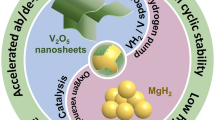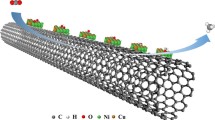Abstract
Electrochemical water splitting is quite seductive for eco-friendly hydrogen fuel energy production, however, the attainment of highly efficient, durable, and cheap catalysts for the hydrogen evolution reaction (HER) remains challenging. In this study, molybdenum oxides stabilized palladium nanoparticle catalysts (MoOx-Pd) are in situ prepared on commercial carbon cloth (CC) by the facile two-step method of dip-coating and electrochemical reduction. As a self-supported Pd-based catalyst electrode, the MoOx-Pd/CC presents a competitive Tafel slope of 45.75 mVdec−1, an ultralow overpotential of 25 mV, and extremely long cycling durability (one week) in 0.5 M H2SO4 electrolyte, superior to unmodified Pd catalysts and comparable to commercial Pt mesh electrode. On the one hand, the introduction of MoOx can inhibit the growth of Pd particles to obtain ultrafine Pd nanoparticles, thus exposing more available active sites. On the other hand, density functional theory (DFT) calculation revealed that MoOx on the surface of Pd metal can regulate the electronic structure of Pd metal and enhance its intrinsic catalytic activity of HER. This work suggests that transitional metal nanoparticles stabilized by molybdenum oxides are hopeful approaches for obtaining fruitful hydrogen-producing electrocatalysts.

Similar content being viewed by others
References
Schlapbach, L.; Züttel, A. Hydrogen-storage materials for mobile applications. Nature 2001, 414, 353–358.
Eberle, U.; Felderhoff, M.; Schüth, F. Chemical and physical solutions for hydrogen storage. Angew. Chem., Int. Ed. 2009, 48, 6608–6630.
Yu, P.; Wang, F. M.; Shifa, T. A.; Zhan, X. Y.; Lou, X. D.; Xia, F.; He, J. Earth abundant materials beyond transition metal dichalcogenides: A focus on electrocatalyzing hydrogen evolution reaction. Nano Energy 2019, 58, 244–276.
Ge, R. X.; Li, L.; Su, J. W.; Lin, Y. C.; Tian, Z. Q.; Chen, L. Ultrafine defective RuO2 electrocatayst integrated on carbon cloth for robust water oxidation in acidic media. Adv. Energy Mater. 2019, 9, 1901313.
Lei, Y P.; Wang, Y. C.; Liu, Y; Song, C. Y.; Li, Q.; Wang, D. S.; Li, Y. D. Designing atomic active centers for hydrogen evolution electrocatalysts. Angew. Chem., Int. Ed., in press, DOI: https://doi.org/10.1002/anie.201914647.
Anjum, M. A. R.; Okyay, M. S.; Kim, M.; Lee, M. H.; Park, N.; Lee, J. S. Bifunctional sulfur-doped cobalt phosphide electrocatalyst outperforms all-noble-metal electrocatalysts in alkaline electrolyzer for overall water splitting. Nano Energy 2018, 53, 286–295.
Mahmood, N.; Yao, Y. D.; Zhang, J. W.; Pan, L.; Zhang, X. W.; Zou, J. J. Electrocatalysts for hydrogen evolution in alkaline electrolytes: Mechanisms, challenges, and prospective solutions. Adv. Sci. 2018, 5, 1700464.
Carmo, M.; Fritz, D. L.; Mergel, J.; Stolten, D. A comprehensive review on PEM water electrolysis. Int. J. Hydrogen Energy 2013, 38, 4901–4934.
Slavcheva, E.; Radev, I.; Bliznakov, S.; Topalov, G.; Andreev, P.; Budevski, E. Sputtered iridium oxide films as electrocatalysts for water splitting via PEM electrolysis. Electroch. Acta 2007, 52, 3889–3894.
Xu, J.; Zhang, C. X.; Liu, H. X.; Sun, J. Q.; Xie, R. C.; Qiu, Y.; Lü, F.; Liu, Y. F.; Zhuo, L. C.; Liu, X. J. et al. Amorphous MoOX-stabilized single platinum atoms with ultrahigh mass activity for acidic hydrogen evolution. Nano Energy 2020, 70, 104529.
Zhu, L. L.; Lin, H. P.; Li, Y. Y.; Liao, F.; Lifshitz, Y.; Sheng, M. Q.; Lee, S. T.; Shao, M. W. A rhodium/silicon co-electrocatalyst design concept to surpass platinum hydrogen evolution activity at high overpotentials. Nat. Commun. 2016, 7, 12272.
Yao, Y. C.; Gu, X. K.; He, D. S.; Li, Z. J.; Liu, W.; Xu, Q.; Yao, T.; Lin, Y.; Wang, H. J.; Zhao, C. M. et al. Engineering the electronic structure of submonolayer Pt on Intermetallic Pd3Pb via charge transfer boosts the hydrogen evolution reaction. J. Am. Chem. Soc. 2019, 141, 19964–19968.
Smiljanic, M.; Rakocevic, Z.; Maksic, A.; Strbac, S. Hydrogen evolution reaction on platinum catalyzed by palladium and rhodium nanoislands. Electroch. Acta 2014, 117, 336–343.
Vasić, D. D.; Pašti, I. A.; Mentus, S. V. DFT study of platinum and palladium overlayers on tungsten carbide: Structure and electrocatalytic activity toward hydrogen oxidation/evolution reaction. Int. J. Hydrogen Energy 2013, 38, 5009–5018.
Bai, S.; Wang, C. M.; Deng, M. S.; Gong, M.; Bai, Y.; Jiang, J.; Xiong, Y. J. Surface polarization matters: Enhancing the hydrogen-evolution reaction by shrinking Pt shells in Pt–Pd–graphene stack structures. Angew. Chem., Int. Ed. 2014, 53, 12120–12124.
Noerskov, J. K.; Bligaard, T.; Logadottir, A.; Kitchin, J. R.; Chen, J. G; Pandelov, S.; Stimming, U. Trends in the exchange current for hydrogen evolution. J. Electrochem. Soc. 2005, 152, J23–J26.
Shen, S. Y.; Zhao, T. S.; Xu, J. B.; Li, Y. S. Synthesis of PdNi catalysts for the oxidation of ethanol in alkaline direct ethanol fuel cells. J. Power Sources 2010, 195, 1001–1006.
Ambriz-Peláez, O.; Durón, S.; Olivas, A.; Valdez, R.; Arriaga, L. G.; Álvarez-Contreras, L.; Guerra-Balcázar, M.; Arjona, N. Effect of molybdenum content on the morphology and electronic characteristics of Pd-MoOx nanomaterials and activity evaluation for ethylene glycol electro-oxidation. Appl. Surf. Sci. 2019, 498, 143842.
Feng, L. G; Cui, Z. M.; Yan, L.; Xing, W.; Liu, C. P. The enhancement effect of MoOx on Pd/C catalyst for the electrooxidation of formic acid. Electroch. Acta 2011, 56, 2051–2056.
Chi, K.; Tian, X.; Wang, Q. J.; Zhang, Z. Y.; Zhang, X. Y.; Zhang, Y.; Jing, F.; Lv, Q. Y.; Yao, W.; Xiao, F. et al. Oxygen vacancies engineered CoMoO4 nanosheet arrays as efficient bifunctional electrocatalysts for overall water splitting. J. Catal. 2020, 381, 44–52.
Ma, T. Y.; Dai, S.; Qiao, S. Z. Self-supported electrocatalysts for advanced energy conversion processes. Mater. Today 2016, 19, 265–273.
Mondschein, J. S.; Callejas, J. F.; Read, C. G.; Chen, J. Y. C.; Holder, C. F.; Badding, C. K.; Schaak, R. E. Crystalline cobalt oxide films for sustained electrocatalytic oxygen evolution under strongly acidic conditions. Chem. Mater. 2017, 29, 950–957.
Yang, X. L.; Li, H. N.; Lu, A. Y.; Min, S. X.; Idriss, Z.; Hedhili, M. N.; Huang, K. W.; Idriss, H.; Li, L. J. Highly acid-durable carbon coated Co3O4 nanoarrays as efficient oxygen evolution electrocatalysts. Nano Energy 2016, 25, 42–50.
Ge, R. X.; Wang, S.; Su, J. W.; Dong, Y.; Lin, Y. C.; Zhang, Q. J.; Chen, L. Phase-selective synthesis of self-supported RuP films for efficient hydrogen evolution electrocatalysis in alkaline media. Nanoscale 2018, 10, 13930–13935.
Haddad, N.; Bordes-Richard, E.; Barama, A. MoOx-based catalysts for the oxidative dehydrogenation (ODH) of ethane to ethylene: Influence of vanadium and phosphorus on physicochemical and catalytic properties. Catal. Today 2009, 142, 215–219.
Ressler, T.; Jentoft, R. E.; Wienold, J.; Günter, M. M.; Timpe, O. In situ XAS and XRD studies on the formation of mo suboxides during reduction of MoO3. J. Phys. Chem. B 2000, 104, 6360–6370.
He, G. Q.; Song, Y.; Liu, K.; Walter, A.; Chen, S.; Chen, S. W. Oxygen reduction catalyzed by platinum nanoparticles supported on graphene quantum dots. ACS Catal. 2013, 3, 831–838.
Dobrea, I. D.; Ciocan, C. E.; Dumitriu, E.; Popa, M. I.; Petit, E.; Hulea, V. Raman spectroscopy-Useful tool for studying the catalysts derived from Mo and V-oxyanion-intercalated layered double hydroxides. Appl. Clay Sci. 2015, 104, 205–210.
Yan, J. M.; Zhang, X. B.; Han, S.; Shioyama, H.; Xu, Q. Ironnanoparticle-catalyzed hydrolytic dehydrogenation of ammonia borane for chemical hydrogen storage. Angew. Chem., Int. Ed. 2008, 47, 2287–2289.
Tsukada, C.; Ogawa, S.; Niwa, H.; Nomoto, T.; Kutluk, G.; Namatame, H.; Taniguchi, M.; Yagi, S. Morphological and spectroscopic studies on enlargement of Pd nanoparticle in L-cysteine aqueous solution by AFM and XPS. Appl. Surf. Sci. 2013, 267, 48–52.
Choi, J. G.; Thompson, L. T. XPS study of as-prepared and reduced molybdenum oxides. Appl. Surf. Sci. 1996, 93, 143–149.
Sun, P.; Wang, B. Q.; Zhao, L. P.; Gao, H. Y.; Wang, T. S.; Yang, X. L.; Liu, C.; Lu, G. Y. Enhanced gas sensing by amorphous double-shell Fe2O3 hollow nanospheres functionalized with PdO nanoparticles. Sens. Actuators B Chem. 2017, 252, 322–329.
Brandhorst, M.; Cristol, S.; Capron, M.; Dujardin, C.; Vezin, H.; Le Bourdon, G.; Payen, E. Catalytic oxidation of methanol on Mo/Al2O3 catalyst: An EPR and Raman/infrared operando spectroscopies study. Catal. Today 2006, 113, 34–39.
Liu, Q. W.; Wu, Y. W.; Zhang, J. W.; Chen, K. J.; Huang, C. J.; Chen, H.; Qiu, X. Q. Plasmonic MoO3-x nanosheets with tunable oxygen vacancies as efficient visible light responsive photocatalyst. Appl. Surf. Sci. 2019, 490, 395–402.
Jiang, B. B.; Yang, L. L.; Liao, F.; Sheng, M. Q.; Zhao, H. Z.; Lin, H. P.; Shao, M. W. A stepwise-designed Rh-Au-Si nanocomposite that surpasses Pt/C hydrogen evolution activity at high overpotentials. Nano Res. 2017, 10, 1749–1755.
Lu, H. Y.; Fan, W.; Huang, Y. P.; Liu, T. X. Lotus root-like porous carbon nanofiber anchored with CoP nanoparticles as all-pH hydrogen evolution electrocatalysts. Nano Res. 2018, 11, 1274–1284.
Pan, Y.; Zhang, C.; Lin, Y.; Liu, Z.; Wang, M. M.; Chen, C. Electrocatalyst engineering and structure-activity relationship in hydrogen evolution reaction: From nanostructures to single atoms. Sci. China Mater. 2020, 63, 921–948.
Yan, X. D.; Tian, L. H.; Atkins, S.; Liu, Y.; Murowchick, J.; Chen, X. B. Converting CoMoO4 into CoO/MoOx for overall water splitting by hydrogenation. ACS Sustainable Chem. Eng. 2016, 4, 3743–3749.
Geng, S.; Liu, Y. Q.; Yu, Y. S.; Yang, W. W.; Li, H. B. Engineering defects and adjusting electronic structure on S doped MoO2 nanosheets toward highly active hydrogen evolution reaction. Nano Res. 2020, 13, 121–126.
Luo, M. C.; Zhao, Z. L.; Zhang, Y. L.; Sun, Y. J.; Xing, Y.; Lv, F.; Yang, Y.; Zhang, X.; Hwang, S.; Qin, Y. N. et al. PdMo bimetallene for oxygen reduction catalysis. Nature 2019, 574, 81–85.
Lu, S. J.; Wang, W. J.; Yang, S. S.; Chen, W.; Zhuang, Z. B.; Tang, W. J.; He, C. H.; Qian, J. J.; Ma, D. K.; Yang, Y. et al. Amorphous MoS2 confined in nitrogen-doped porous carbon for improved electrocatalytic stability toward hydrogen evolution reaction. Nano Res. 2019, 12, 3116–3122.
Zhu, J. Q.; Wang, Z. C.; Dai, H. J.; Wang, Q. Q.; Yang, R.; Yu, H.; Liao, M. Z.; Zhang, J.; Chen, W.; Wei, Z. et al. Boundary activated hydrogen evolution reaction on monolayer MoS2. Nat. Commun. 2019, 10, 1348.
Acknowledgements
This work was financially supported by the Natural Science Foundation of China (Nos. 51902312 and 51672277), the young project of Anhui Provincial Natural Science Foundation (No. 1908085QB83), the China Postdoctoral Science Foundation funded project (No. 2019M652224), the CAS Pioneer Hundred Talents Program, and the CAS/SAFEA International Partnership Program for Creative Research Teams of Chinese Academy of Sciences, China.
Author information
Authors and Affiliations
Corresponding authors
Electronic Supplementary Material
12274_2020_3083_MOESM1_ESM.pdf
Robust enhanced hydrogen production at acidic conditions over molybdenum oxides-stabilized ultrafine palladium electrocatalysts
Rights and permissions
About this article
Cite this article
Sun, J., Zhang, X., Jin, M. et al. Robust enhanced hydrogen production at acidic conditions over molybdenum oxides-stabilized ultrafine palladium electrocatalysts. Nano Res. 14, 268–274 (2021). https://doi.org/10.1007/s12274-020-3083-3
Received:
Revised:
Accepted:
Published:
Issue Date:
DOI: https://doi.org/10.1007/s12274-020-3083-3




